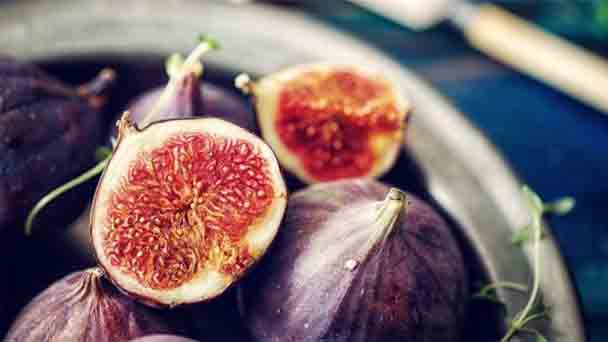Figs Profile
Written by Joy
Nov 06 2020

Figs are plants of Moraceae and Ficus. Deciduous shrubs or small trees; up to 10 meters high, multi-branched; bark gray-brown, with obvious lenticels; branchlets are thick, leaves alternate, thick paper, broadly ovoid, 10-20 cm long and wide, palmate 3-5 lobed, Small lobes ovoid, with irregular blunt teeth. The petiole of the fig is thick and 2-5 cm long; the fig is dioecious, and the male flowers and the galls are co-grown on the inner wall of a banyan, the male flowers are clustered orifices, the female perianth is the same as the male flowers, and the style is lateral; the ficus has solitary leaf axils, Pear-shaped, 3-5 cm in diameter, concave at the top, purple or yellow when ripe, 3 basal bracts, ovoid, achene lenticular. The flowering and fruiting period of figs is from May to July.

Figs morphological characteristics
Figs are deciduous shrubs or small trees, the whole plant is milky; up to 3-10 meters, many branches; the bark is gray-brown with obvious lenticels; the branchlets are erect and thick. Leaves alternate, thick paper, broadly ovoid, approximately equal in length and width, 10-20 cm, usually 3-5 lobed, small lobes ovoid, with irregular blunt teeth on the edge, rough surface, dense small stalactites and back Gray pubescent, shallow heart-shaped base, 3-5 basal lateral veins, 5-7 pairs of lateral veins; petiole 2-5 cm long and stout. The stipules of figs are ovate-lanceolate, about 1 cm long and red.Figs are dioecious plants. Male flowers and gall flowers are found on the inner wall of a banyan, the mouth of the inner wall of male peanuts, tepals 4-5, stamens 3, sometimes 1 or 5, and the gall flower styles are lateral, short; female flowers Tepals same as male flowers, ovary ovoid, smooth, style lateral, stigma 2-lobed, linear. Ficus solitary leaf axils, large and pear-shaped, 3-5 cm in diameter, depressed at the top, purple or yellow when mature, 3 basal bracts, ovoid.
Figs growth habit and growing environment and distribution
Soil

Temperature
Figs are not cold-tolerant. When the temperature reaches -12°C in winter, the top of the new shoots will start to freeze; at -20°C, the entire aerial part above the rhizome will freeze to death. Figs can tolerate higher temperatures without harm. Generally speaking, it is suitable for warmer climates. The annual average temperature is 15℃, the average maximum temperature in summer is 20℃, and the average minimum temperature in winter is 8℃. The area where the biological accumulated temperature above 5°C reaches 4800°C is most beneficial to the growth of figs.Illumination
Figs are light-loving trees.Moisture

Figs are distributed along the Mediterranean coast, from Turkey to Afghanistan; they were introduced from Persia in the Tang Dynasty of China and are cultivated in both the north and the south, especially in the south of Xinjiang.
Figs efficacy and role
The economic value of figs
Figs are one of the oldest cultivated fruit trees in the world with high economic value. The fruit can be processed into jam, preserved fruit, canned food, fruit juice, fruit powder, candied fruit, syrup and a series of beverages, etc. For this reason, both China and abroad attach great importance to the research and development of figs, and its series of products have doubled in value.
The ecological value of figs
The fig tree is elegant and is an ornamental tree in gardens and parks. Figs have large leaves, palm-shaped cracks, and rough leaf surfaces. They have a good dust collection effect. If they are configured with other plants, they can also form a good noise barrier. Figs can resist toxic gases and air pollution that ordinary plants cannot tolerate, and are good tree species for greening in chemically polluted areas. In addition, figs are highly adaptable, resistant to wind, drought, and salt-alkali. When planted in coastal areas, they can prevent wind and fix sand and green the beach.Figs cultivation

Cutting propagation
Selection and storage of cuttingsSelection of cuttings: The cuttings are usually cut after falling leaves in autumn or before the sap flows in early spring. Cuttings should be selected from good varieties with strong growth, annual or biennial branches with substantial tissues, leaf buds: full, with a thickness of more than 1 cm.
Storage of cuttings: Cut the cuttings to a length of 20 cm, and bundle each 50-100 into a bunch. In autumn, the strips should be buried in the soil to survive the winter, and the strips can be inserted in the spring. During the storage process, always keep the soil moisture to prevent the cuttings from draining and moldy.
Cutting time and method
Cutting time: The cuttings of figs are generally divided into spring cuttings and autumn cuttings, and spring cuttings are the main ones. Therefore, the cuttings store more nutrients and the cutting survival rate is high. The cuttings should be in the bud swelling period, and the cuttings in the open field in the north should be from late March to mid-April. Because cuttings are good for rooting when the local temperature reaches 15°C or higher, they are vulnerable to freezing damage too early, and they tend to lose water and dry up due to high temperatures too late. In the south, it can be early, such as the use of protected areas to raise seedlings can be cut earlier in January.
Grafting reproduction
Figs are a tree species that is easy to survive by cuttings. Generally, cuttings are used for reproduction. However, grafting is required to speed up the reproduction coefficient of fine varieties and introduce fine varieties and improved varieties.Selection, transportation and storage of scion.

Ear harvesting during the dormant period can be combined with pruning in winter and spring, and the pruned branches in winter should be buried in wet sand for preservation. Pruning combined with grafting before germination in spring is also possible. Scion collected from other places can be a bundle of 50 or 100 branches, label the variety, name, origin, etc., wrap it with thin grass or straw when packing and transporting, and put aquatic grass or wet sawdust in the box as filling material. After delivery to the destination, immediately unpack the scion and store it in wet sand, which can be stored for 15-20 days. For budding in summer, the leaves should be cut as soon as they are picked to prevent water evaporation. In summer, the temperature is high, the scion should be stored in a cool kiln, inserted in wet sand, and moisturized frequently, but pay attention to prevent mold. It can also be hung above the water surface of a deep well for preservation.
Grafting method
Budding method: ① T-shaped budding method. Grafting in hot summer days. The method is to make a cross-cut on the rootstock, then cut a bit straight below the center of the cross-cut, use the tip of a knife to lift the cortex from the cut, and then pinch the prepared scion sticks upside down or smoothly in your hand, and use the budding knife Cut or reverse the fig buds to leave a small piece of petiole to check survival. Then use the index finger and thumb of your right hand to tie the plastic band of the bud piece to leave the bud, and tie the knife tightly to facilitate survival;
②Budding with xylem: two methods: meristem and dormancy. The dormant grafting method is to cut a shield-shaped bud piece from the rootstock first, and then take a shield-shaped bud piece of the same size from the scion, and stick the bud piece on the beveled surface of the rootstock. Pay attention to the tight grafting and the cambium should be aligned, The exposed buds are tied tightly. The method of budding with xylem in the growing season is the same as above, but with as little wood as possible, a small piece of petiole should be left, and the buds and petioles should be reserved when binding, so as to check survival. This method can overcome the difficulty of not separating the scion, thereby prolonging the grafting time in the growing season.

②Single bud abdominal grafting method: carry out before germination or growth period. The leaves of the scion cut off during the growth period should be cut off, leaving only the petiole.
③ Splitting method: Use this method when the rootstock is thicker than the scion. After the rootstock has its head removed, it is split from the middle, and both sides of the scion are cut into a horse-ear-shaped bevel, with a wide cortex on one side and a narrower side on the other. Insert the wide side of the cortex against the cortex of the rootstock through the cleft, aiming at the cambium, and then withdraw it The knife is bound again.
Latest Updated
- Benefits of Bugleweed - 7 Science-backed Health Benefits
- Bugleweed Dangers & Side Effects - Is It Poisonous?
- How to Plant Evergreen Trees - What You Should Know
- When to Plant Evergreens - Grow Guide for Evergreen Trees
- 12 Wonderful Evergreen Shrubs for Your Garden
- 12 Popular Evergreen Plants with Pictures for Beginners
- When And How To Prune A Lilac Bush Like a Pro
- How to Grow & Care for Lilac Vine (Hardenbergia Violacea)
- Japanese Lilac Tree (Syringa Reticulata) Care & Propagation Guide
- Shumard Oak Pros and Cons - What to Know
Popular Articles
- Winter maintenance of Antirrhinum Majus
- How to Grow Terminalia Mantaly Tree
- How to Grow and Care for Crossostephium Chinense
- How to grow Antirrhinum Majus in spring
- Peristeria Elata (Dove Orchid) Profile: Info & Care Guide
- Underwatered Snake Plant (Sansevieria Trifasciata) - Signs And How To Fix
- How to Care for Brazilian Jasmine Plant (Mandevilla Sanderi)
- How to Grow & Care for Graptopetalum Purple Delight in Summer
- Rosa Chinensis (China Rose): Plant Growing & Care Tips
- How to Care for Baby Sun Rose (Aptenia Cordifolia)